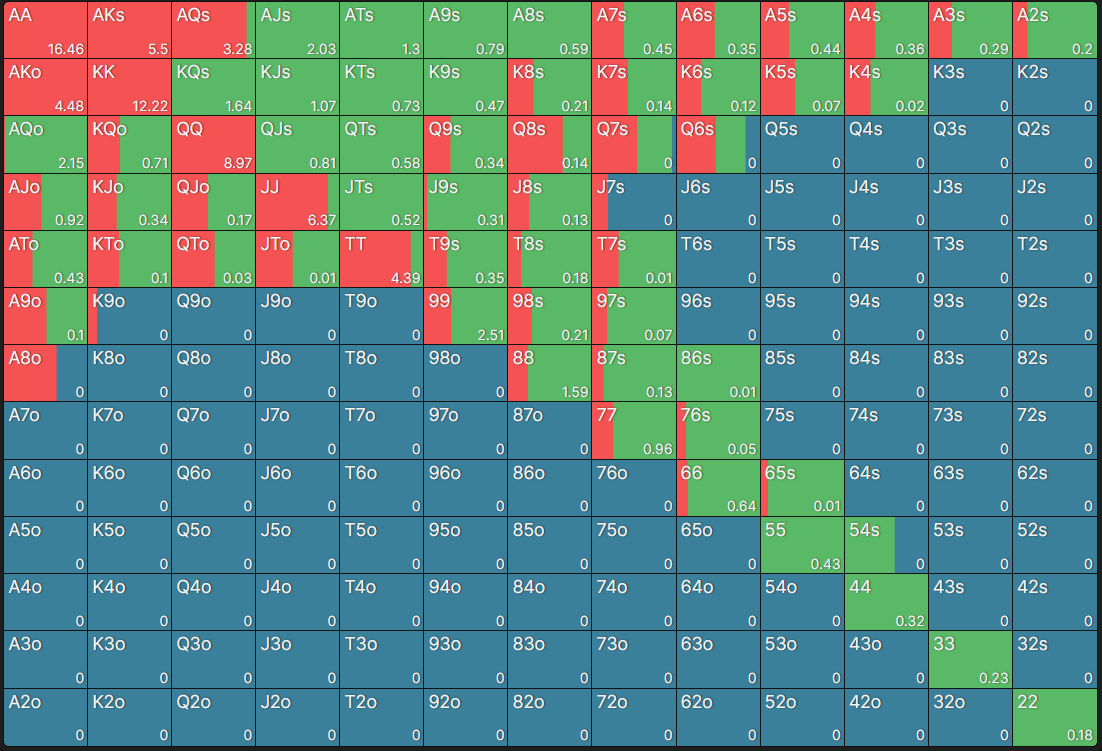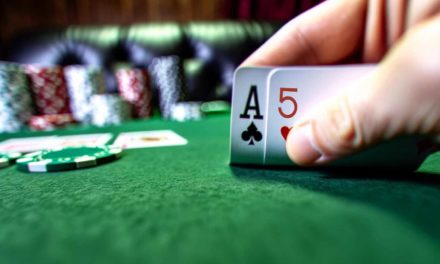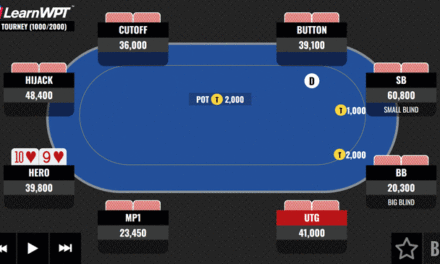
So far, we’ve talked about how to exploitatively adjust your preflop opening hand ranges based on both player-specific reads and table dynamics. One crucial component we haven’t discussed much up until now is how to exploitatively adjust your 3-betting and 4-betting ranges while at the table.
GTO Mixed Strategies
When you study GTO 3-betting and 4-betting strategies, the first thing most players notice is that there are A LOT of mixed strategies going on. GTO solvers like to 3-bet and 4-bet with a lot of hands some small percentage of the time. Since we’re not NegreanuGPT or IveyAI mixing strategies at the table becomes a real challenge. There are methods we can use, such as the seconds on the tournament clock or the suits of our cards. For example, if the tournament clock is an odd number, you raise if it fits your mixed strategy, and if it is an even number, you just call.

Sample of a Button vs Cutoff 3-betting range with a GTO mixed strategy.
One question we want to ask ourselves is:
“Why does the solver choose a mixed strategy instead of just picking some of the available hands and 3-betting them 100% of the time?”
The primary reason for this is against a perfect opponent; we want to have good board coverage postflop.
If we were just to raise all our big pairs and Ax hands, we would be raising very close to the same frequency of hands, but postflop, we would miss a vast majority of boards that didn’t contain an ace. Using the mixed strategy makes it harder for our opponents to play against us on a J-8-4 flop because we can have hands like overpairs, J8s, JJ, and 88 in our range, in addition to a lot of big cards that missed.
As we discussed in part 1 of this series, in any instance where a solver is using a mixed strategy, the EV (expected value) of each strategy is either equal or very close to the same. When that’s the case, other factors, such as information on how our opponents play, start to play a much bigger role in the profitability of if we 3-bet or call with a given holding.
So, what specific things might we be looking to make exploitative adjustments against?
Range Gap Exploits
The single biggest factor in an exploitative 3-betting or 4-betting strategy is your opponent’s “range gap.”
The range gap is the difference between the number of hands currently in your opponent’s range versus the hands they will continue with if you were to take another aggressive action.
For example, if your opponent is opening in the cutoff with around 30% of hands, and if you 3-bet them, they will fold everything but the top 6% of hands. Therefore, they are folding to your 3-bet four times out of five, or 80%!
If your opponent is opening to 2.5 BBs and you 3-bet to 7.5 BBs, you are risking 7.5 to win 5 BBs (the 2.5 BB raise plus the big blind, the small blind, and the big blind ante). With this risk-to-reward ratio, any time your opponent is folding more than 60% of the time, you show an auto-profit, even if you never win the pot postflop (assuming you don’t put more money in postflop).
So, if the range gap between what your opponent opens and what they call with is too wide, you can exploitatively 3-bet a much wider range.
Key things to look for to identify range gaps are:
- opponents who open too many hands from a given position (it’s easier to have a wide gap when you start with a wide range!)
- and/or opponents who are playing extremely snugly against aggression.
Just because an opponent is tight doesn’t mean a range gap doesn’t exist. If your opponent is opening only 10% of hands, they still have a significant range gap if they fold everything but QQ+/AK (roughly 2.5% of hands). If they open 30% of hands but never fold to 3-bets, that’s not a range gap!
As a general rule, if a range gap exists, you want to:
- ramp up your 3-betting frequency (or 4-betting if the range gap is in their 3-bet range versus 4-bet continuing range), and
- utilize a more polarized range that prioritizes hands with blockers (like Ax/Kx and even some Qx) in addition to stronger hands.
If your opponent calls 3-bets too frequently, then you want to 3-bet a more linear range, which is a range that mostly consists of hands that are better than your opponent’s opening range.
Opponents Yet to Act
The second thing you want to consider is who is left to act behind you and anything you know about their tendencies.
For example, if you have aggressive players in the blinds who like to squeeze a lot, then you would want to 3-bet the mixed hands more often and call with them less because when you call, you are much more likely to be facing a re-raise from one of the blinds.
Against these types of players, you’d also be more inclined to slow-play some of your better 3-betting hands to induce a squeeze from the blinds and get to play a large pot in a situation where your hand has a huge edge over their range.
If the players in the blinds are much weaker and more passive, you may be more inclined just to call a raise so you can play postflop against the weaker players. You also know that when they do squeeze, it is much more likely to be a real hand and can react appropriately.
It is also important to consider the stack sizes yet to act behind you and how your 3-betting or calling may do things like induce a squeeze from a ~20 BB stack or a 3-bet may pot commit you against a shorter stack behind you, making your risk amount on the 3-bet higher than you might think since you are committed to calling more chips in some situations.
Playing Against Multiple Opponents
When there is a raise with multiple callers, and you don’t have a speculative hand you can call with, the main decision is if you should squeeze or not.
Some of the previous concepts, such as the range gap, come into play. The primary players you want to pay attention to are the initial raiser and the last caller. Those two players are most likely to defend if you squeeze. The initial raiser because they have an uncapped range. The final caller because they will be closing the action, so they know that they will be heads up and get to see a flop. Everyone in the middle usually has a capped range and is unlikely to continue if the initial raiser folds.
There is also a dynamic that shouldn’t impact play, but it often does because we are all humans at the table with emotions. The last player feels like they are the “last line of defense” against potential steals, so at times, they will call a bit lighter than they should. Knowing whether the last caller is this type of player is very beneficial.
The ideal situation for a squeeze is when you have an initial raiser with a wide opening range and a final caller who doesn’t have a tendency to “play sheriff” and call light. In this scenario, the initial raiser will often feel the “squeeze” of having to face your raise and potential action behind them, which increases the range gap between what they open and what they continue with, while the players behind all have capped calling ranges that make it difficult to continue.
One last note: you do need to be aware that a single caller behind an opener will sometimes be inducing a squeeze as well if they are a good player. Against solid players capable of this you will want to squeeze lightly less often and choose hands with key blockers (such as an ace or king) as primary squeezing candidates.
Tying It All Together
 So, let’s say we have a hand like QTo on the button, and it is folded to the cutoff, who opens to 2.5 BBs. If you look at the original GTO chart it’s almost a perfect 50/50 mix of 3-betting and calling! We could just use a strategy where we always 3-bet to 7.5 BBs if the queen is a red card (which would represent 50% of possible combinations), or we could use what we know about our opponent.
So, let’s say we have a hand like QTo on the button, and it is folded to the cutoff, who opens to 2.5 BBs. If you look at the original GTO chart it’s almost a perfect 50/50 mix of 3-betting and calling! We could just use a strategy where we always 3-bet to 7.5 BBs if the queen is a red card (which would represent 50% of possible combinations), or we could use what we know about our opponent.
- Does our opponent open too wide or fold too frequently to 3-bets? If so, we would most definitely want to lean toward 3-betting!
- Do we have tough opponents behind us? If so, we might want to consider 3-betting to make them fold more often and get heads-up with a weaker player.
- Do we have weak opponents behind us who make postflop mistakes? If so, we might want to just call to invite them along.
- Do we have tight opponents who are unlikely to come along and/or squeeze us without a big hand? If so, we could lean toward calling more frequently and taking a flop in position against the cutoff, knowing we are unlikely to be put in many difficult situations. When we are, they likely have a big hand!
In a GTO world, 3-betting and 4-betting strategies are often mixed affairs. These are difficult to replicate in real-time, although we can use things like the tournament clock and suits to try and approximate it.
Since these decisions are all very close in the first place, we can use exploitative reasons to govern our 3-betting and 4-betting strategies. Things like our opponent’s likely range gap and the tendencies of our opponents behind us can allow us to significantly enhance our win rate against opponents who aren’t playing perfect GTO strategies!
Remember, in the world of poker, exploiting your opponents is not just okay; it’s your ace in the hole.
Until the next deal,
Eric “Rizen” Lynch
To see Rizen PXF videos, go to the PXF Training Center. Eric is an instructor at LearnWPT where he answers questions in their Ask a Pro service, runs live workshops, and hosts live seminars!
To be alerted to future editions to this series, sign up for the free PXF Newletter!






